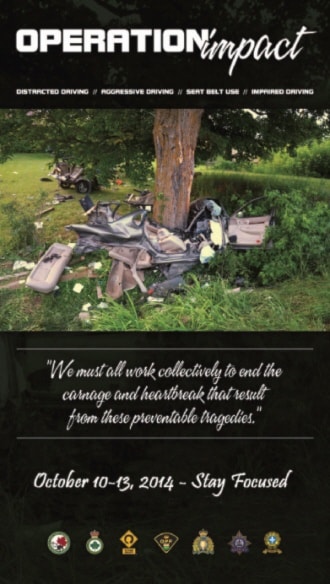Being a dedicated traffic enforcement cop brings with it a lot of tragic and bloody memories that both haunt and galvanize the police who enforce the laws of the road, according to Cpl. Brian Johannson.
Johannson is in charge of the Stettler branch of the Central Alberta Integrated Traffic Unit (ITU). He and Const. Mark Hall operate out of the Stettler RCMP detachment but cover all central Alberta. The unit is made up of 11 RCMP members and five sheriffs from the Solicitor General’s office.
Since the return of the ITU to Stettler in mid- September, Johannson and Hall have handed out slightly more than 250 traffic infractions, including a handful of immediate roadside sanctions – drivers who had their vehicles towed and/or licence suspended for three to 30 days depending on the level of impairment.
“We’re noticing, in this area, a lot of vehicle violations,” Johannson said, unknowingly echoing a previous comment from the detachment commander, Sgt. Duncan Babchuk, who has previously spoken out about vehicle modifications.
“(We see) tinted windows and tinted tail lights,” Johannson said.
While it is legally acceptable to tint rear seat windows in a vehicle, it is not legal to tint the front driver and passenger side windows or the windshield, for both practical and safety reasons.
“When you come to a four-way stop, you’re trained to meet the eyes of the person across from you,” Johannson said. “You can’t do that with tint. And windows are designed to break into little pieces in a collision – tint holds them together.”
He described one collision where the driver’s arm had gone through a window. The window had broken properly, but the glass had held the tiny shards of glass together.
“It was like a serrated knife,” Johannson said. “He needed 600 stitches.”
Traffic also concerns itself with the usual offences, such as speeding, impaired driving, intersection safety, and distracted driving. Unlike some provinces, where there are either no distracted driving laws or less robust hands-free laws, the laws in Alberta dictate that drivers must not have their attention diverted by anything.
“People think driving means getting into your vehicle and going from point A to point B,” Johannson said. “It’s more than that. It requires your complete attention.”
In his eight years in the ITU in Blackfalds, where he served before being promoted to corporal to head up the Stettler division of the Central Alberta ITU, Johannson said he’s seen some ridiculous examples of distracted driving.
“One man was eating a poutine while driving,” he recalled. “He had the food in one hand, fork in the other, and was steering with his knees.”
Another time, a man was flossing his teeth.
Distracted driving laws require drivers to be paying attention. The use of electronic devices like cell phones, computers, tablets, or GPS units, the presence of pets on the lap, and eating are just some examples of how people can find themselves on the wrong side of the distracted driving laws.
The Central Alberta ITU operates out of Blackfalds, Rocky Mountain House and Stettler, and is made up of 11 RCMP members and five sheriffs from the
Solicitor General’s office, all with the not-so-simple mandate of improving road safety while reducing the number of fatal or high injury collisions.
“You want to make sure people are safe,” Johannson said. “It’s why we do what we do, but it becomes disturbing when you see people who have died who shouldn’t have.”
He cited, as an example, a man who died after his vehicle went off the road while his head was down, texting.
Johannson said seatbelt use is the best protective step people can take.
“The inside of a vehicle has what’s called the engineered life space,” he said. “It’s specially designed to handle collisions and protect vehicle occupants. The seat belt will keep you inside that engineered life space.
“Seventy-five per cent of people ejected from a vehicle in a collision die. Lap/shoulder belts reduce the risk of fatal or serious injuries to front seat occupants of passenger vehicles by up to 50 per cent and by up to up 65 per cent for people riding in light trucks.”
He said some people explain away their decision to not wear their seatbelts as concern about going into water, but the number of water-seatbelt deaths is very rare in comparison to the numbers of those who have died in vehicle ejections, Johannson noted.
The Stettler branch of the ITU isn’t limited to Stettler County, but can be found all over Central Alberta.
